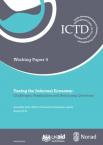ICTD Working Paper 15
This paper is focused on the question: why do the governments of low income countries not raise more tax revenues? Two different but complementary approaches are used to answer it. The first approach is comparisons: among countries today, and within countries over time. This approach tends to generate relatively conservative answers to the central question. It leads to an emphasis on the ‘sticky’ nature of the taxation. For any individual country in ‘normal times’ – i.e. excluding situations of war, major internal conflict, the collapse or rapid reconstruction of state power – revenue collections, measured as a proportion of GDP, do not change much from year to year. This is partly because effective taxation systems require a great deal of coordination and cooperation between revenue agencies and other organisations, both inside and outside the public sector. It is hard quickly to improve the effectiveness of a complex organisational network. The ‘stickiness’ of tax collections also reflects the fact that the overall tax take – i.e. the proportion of GDP raised as public revenue – is to a significant degree determined by the structure of national economies. For logistical reasons, it is much easier to raise revenue from economies (a) that are high income, urban and non-agricultural and (b) where the ratio of international trade to GDP is high. The government of the average low income country raises less than 20 per cent of GDP in revenue. It makes no sense for such governments to aim to match OECD tax takes of 30-45 per cent of GDP.
